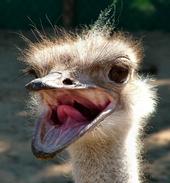Music:
Member Since: 20/07/2006
Band Members: Founding Members
Bruce Gordon - Bass
Steve Ballstadt - Drums
The Expanding Ostrich Collective
Jeremy Kelly - Guitar
Lyle Crilly - Sexy Laptop
Daniel Mansilla - Percussion
Sounds Like:
Amon Tobin, David Axelrod, Anti Balas, Beastie Boys (In Sounds From Way Out!), Congotronics, 4 Hero, Galactica Blast, Godspeed You! Black Emperor, Holy Fuck, Isotope 217, King Brand Valium, Medeski Martin Wood, Mogwai, Ostrich, Portishead, Quantic, Red Snapper, Squarepusher, Suba, The New Deal, Tortoise, Zero 7
The ostrich, Struthio camelus, is the world's largest bird. It is native to Africa, and grows to a height of about 2.3 metres, weighing as much as 180 kilograms when fully grown. Ostriches have been raised as domestic birds for over 100 years, first for their feathers and now for leather and meat. Ostriches skeletons and fossils have been found which date back 120 million years.
Ostriches are herbivorous ... they live mostly on plant matter, like grass and flower seed heads. Occasionally in the wild they will also eat locusts and animal remains left by predators. Ostriches can survive without water for long periods of time. An ostrich in captivity requires 3.5 kg of food every day.
In the wild, ostriches live together in small flocks, usually in the company of antelope and zebras, and covering territories of several square kilometres. Ostriches cannot fly.
A male ostrich is called a rooster, and a female is called a hen. The male is black with white wing tips and tail plumes. The female has light brown and grey feathers, and is slightly smaller than the male. Unlike most other birds, which have three or four toes, the ostrich has just two.
Ostriches also do well in captivity, and both captive and wild ostriches may live up to 50 years. Their powerful legs are their main defense. They can achieve speeds of up to 60 km/h; they are the second fastest animal in the world (after the cheetah), and the fastest two-legged animal. They can maintain this speed for at least 30 minutes. If cornered they can deliver a powerful blow with their legs.
Ostriches were often killed for their hides, which make good leather, and their feathers. Their eggs, which contain the equivalent of about 24 chicken eggs, are eaten by animals as well as humans. It would take approximately 40 minutes to hard-boil an ostrich egg. African tribes use ostrich shells as a means of holding water for bathing and drinking.
Ostriches are very fond of water. They frequently take baths when given the opportunity. Sometimes, in order to hide from predators, ostriches may lie on the ground with their necks outstretched. This behavior is probably the origin of the myth that ostriches bury their heads in the ground.
Today, ostriches are raised in about 50 countries around the world to provide meat and leather. Ostrich meat is a red meat that is very low in cholesterol and calories, and is almost fat free. Ostrich meat resembles beef in its appearance, and is cooked almost the same way.
Ostriches are not an endangered species; there are about 2 million of them worldwide.
Territorial ostrich males compete for flocks of 3 to 5 females. The males use elaborate displays, including hissing and other noises, to intimidate each other. Ostriches in some areas share nests, which are merely large holes scraped in the ground, and which will hold anywhere up to 60 eggs.
An average egg is 15 cm long, and weighs 1.4 kg.
A female ostrich can lay between 40 and 100 eggs per year; the eggs take about 40 days to hatch. Caring for the eggs is done by both the male, during the night, and his mated females during the day.
An ostrich chick grows about 30 cm taller each month until it is about 8 months old.
Type of Label: Major
